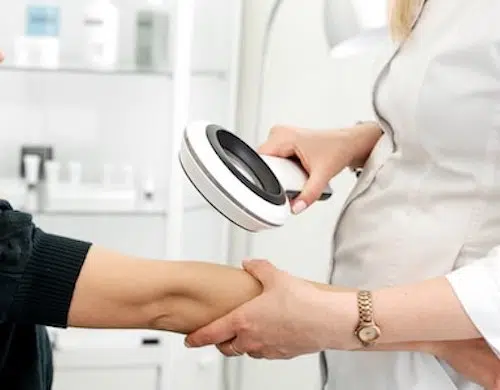
Allergy Patch Testing
Allergy patch testing is a common test used to confirm the cause of allergic contact dermatitis.
learn moreMany of those who suffer from allergic asthma and/or allergic rhinoconjunctivitis (“hay fever”) are allergic to their pets.
Ten to twenty percent of people around the world are allergic to cats and dogs, which are the most common pets in the United States; the American Academy of Allergy, Asthma, and Immunology estimates 161 million cats and dogs live in about 62% of all American homes.
Condition content was medically reviewed by an AllerVie Health physician in Oct. 2022.
Symptoms can vary from person to person, but frequent symptoms include:
For those with asthma, animal allergies can aggravate your asthma with symptoms such as:
Many people who are allergic to animals also have skin symptoms if frequently in direct contact with animals:

Proteins in a furred or feathered animal’s saliva, dander, and urine are what cause animal allergies. Your pet’s hair, fur, or feathers have dander, another word for dead skin cells.
For those who are sensitized to animal dander, when the protein that causes allergies gets into the airways, eyes, nose, mouth, or skin, it causes an allergic reaction.
Pets that can cause allergies include dogs, cats, rabbits, guinea pigs, hamsters, ferrets, birds, and, rarely, horses. Some animal breeds are better than others for people with allergies, but no breed is completely allergy-free, or “hypoallergenic.” If you want a pet that won’t make your allergies worse, choose one that doesn’t have fur or feathers, like fish, turtles, or reptiles.
WHERE ARE PET ALLERGENS FOUND?
There are allergens from pets everywhere. Since allergens can be carried on clothes, they can show up in places where pets have never been. Many surfaces and fabrics can hold allergens from pets. Even after a pet leaves, allergens can stay in the house for up to six months. This is especially true for allergens from cats.
Like many allergies, you are more at risk of pet allergies if you have a family history of allergies or allergic asthma. Also, several research studies have suggested that having a dog or a cat in the home at an early age may decrease the chances of developing dog or cat allergy later in life.
Family history of allergies
Family history of allergic asthma
There are many advanced ways to treat allergies to pets. One of our specialists is the best person to talk to regarding diagnosis and therapy options. You can contact us directly or ask to be put in touch with one of our board-certified allergists who specializes in allergy testing and treatment. During your first appointment, we’ll talk about your symptoms and how long you’ve been having them. We’ll also talk about testing options to help find your triggers and develop a treatment plan that works for you.
Our allergy specialists understand how important pets can be to a family and will work with you to understand the cause and severity of your symptoms. Some tests your allergy specialist may do to diagnose your allergies and draft a treatment plan include:

Allergy Patch Testing
Allergy patch testing is a common test used to confirm the cause of allergic contact dermatitis.
learn more
Blood Testing for Allergies
Blood tests can tell if someone has allergies by finding antibodies in the blood that react to allergens.
learn more
Skin Allergy Testing
This is less invasive than blood tests and is a good alternative for patients who don’t like needles.
learn more
Immunotherapy
Immunotherapy is an ideal choice for patients with severe allergies or those unable to avoid exposure to an allergen.
learn more
If you have pet allergies, it may be beneficial to start with simple over-the-counter treatments that include:
If these over-the-counter treatments aren’t working for you, our allergy specialist may prescribe other medications or allergy shots (also known as immunotherapy).
If you are allergic to a pet, the first step to preventing a reaction is to reduce exposure. This may seem obvious, but any touch with a furry or feathered friend can trigger a reaction if you are allergic.
You can also limit your exposure to pet dander by keeping the pet out of your bedroom and washing your hands thoroughly after handling your pet. Also, know that visitors who own pets can bring pet dander with them on their clothing and luggage. Depending on your sensitivity, even this indirect exposure can trigger pet allergy symptoms. If you will be visiting someone who has pets, plan ahead. Ask that the pet be kept out of the room you will be sleeping in for a few weeks before you arrive. This is also a good time to start taking allergy medicine, to help prevent reactions.
Using a combination of preventative measures has proven to be the most likely to reduce pet allergens in the home. To reduce your exposure, have someone who is not allergic help with the following tasks and home improvements:
Rehoming your pet due to your or a family member’s allergy is a difficult choice to make. But ultimately, it might be your only choice to avoid negative health effects.
*Note: Pet dander can remain in a home for up to 6 months after the pet has been removed.
Remove all pet bedding, equipment, and soft toys
Wipe down hard surfaces including walls, cabinets, and floorboards with a damp microfiber cloth
Remove wall-to-wall carpeting, or at least have it steam cleaned
Steam-clean any fabric furniture or curtains you can’t wash
Change air filters and consider cleaning air ducts.